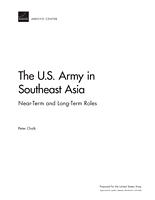| 来源类型 | Research Reports
|
| 规范类型 | 报告
|
| 来源ID | RR-401-A
|
| The U.S. Army in Southeast Asia: Near-Term and Long-Term Roles |
| Peter Chalk
|
| 发表日期 | 2013
|
| 出版年 | 2013
|
| 页码 | 39
|
| 语种 | 英语
|
| 结论 |
The U.S. Army May Have Changing Roles in Southeast Asia- The current threat environment in Southeast Asia is largely benign: There is very little risk of a major interstate war in the region. Many governments have benefited from a high degree of domestic stability afforded by sustained economic growth. Most substate terrorist and insurgent groups have been largely contained, and none constitutes more than a local challenge. And the main regional hegemon, China, poses no meaningful external threat.
- Under current conditions, the Army's role will focus on supporting defense reform and modernization, helping nations in the region address nonconventional transnational threats, and instituting appropriate means to balance increased Chinese penetration.
- In the near term, if conditions remain similar to what they are now, these areas of focus will not change.
- Should the general outlook deteriorate — perhaps as a result of a severe economic slowdown — the geopolitical environment will become far less certain and more prone to crisis. Governments that have derived legitimacy from rapid development would suffer from a loss of grassroots support. State-to-state rivalries would become more acute, especially with regard to the South China Sea disputes. And natural catastrophes would take on greater security relevance because of tighter fiscal constraints for underwriting disaster preparedness and response.
- To meet these challenges, the United States will need to adopt an agile strategy that is thin in physical presence but broad in programmatic execution.
|
| 摘要 |
- If regional security conditions do significantly deteriorate, the U.S. Army should enhance the defense capacities of partner nations to meet both conventional and nonconventional dangers. This effort should entail expanding military-to-military engagements, helping to build a more viable regional security architecture, and assisting with the procurement of appropriate equipment to augment the self-defense of ASEAN member states.
- If regional security conditions do significantly deteriorate, the U.S. Army should conclude new base agreements for hosting small, mission-oriented expeditionary forces. Deployments of this type would furnish the U.S. military with the opportunity for a more flexible and assertive regional presence while also providing greater scope for a robust surge capacity.
- If regional security conditions do significantly deteriorate, the U.S. Army should expand support for regional humanitarian assistance activities by funding additional tabletop exercises, gifting ground transport and airlift assets, and helping to establish regional disaster relief coordination hubs.
- If regional security conditions do significantly deteriorate, the U.S. Army should initiate appropriate responses to counter a more outwardly adventurist China. The priority should be to institute defense arrangements that are affordable and that do not unduly provoke Beijing into undertaking unilateral action of the type that could threaten U.S. and allied interests.
|
| 主题 | Military Strategy
; Southeast Asia
; Threat Assessment
; United States Army
|
| URL | https://www.rand.org/pubs/research_reports/RR401.html
|
| 来源智库 | RAND Corporation (United States)
|
| 资源类型 | 智库出版物
|
| 条目标识符 | http://119.78.100.153/handle/2XGU8XDN/107538
|
推荐引用方式
GB/T 7714 |
Peter Chalk. The U.S. Army in Southeast Asia: Near-Term and Long-Term Roles. 2013.
|
|
文件名:
|
1398862263069.gif
|
|
格式:
|
GIF
|

|
文件名:
|
RAND_RR401.pdf
|
|
格式:
|
Adobe PDF
|
除非特别说明,本系统中所有内容都受版权保护,并保留所有权利。